Groupers
Overview
Groupers are members of the Serranidae family. Members of Serranidae family typically have opercles (gill covers) with three spines; one main spine with a lesser spine above and below. The name "grouper" comes from the Portuguese name "garoupa" for the fish. Contrary to their name which suggests the fish stays in group, they are actually the solitary type. Unlike snappers which move in groups, they are intolerant of the same species or other similar fishes. Most species gather together in pairs or aggregations only for spawning.Groupers are mostly demersal (benthic or bottom-oriented) fishes of tropical and subtropical areas, ranging from shallow coastal waters to moderate depths; the great majority of species occur in less than 200 meters. They are usually found over coral reefs, and rocky bottoms along the coasts.
Typical groupers have a stout body and a large mouth. They do not have many teeth on the edges of their jaws, but they have heavy crushing tooth palates inside they pharynx. Their mouth and gills form a powerful sucking system that can suck their prey in from a distance. They habitually eat fishes, squids, and crustaceans. They swallow their prey rather than biting pieces of it and that makes them easy to get hook by bait. Normally a squid bait can be used over and over again.
Groupers are some of the top predators on coral reefs. Their colouration and ability to change hues and shades to blend in with their surroundings allow them to camouflage and lie in wait for prey rather than chasing in open water. They will ambush, dash and strike the prey in short distance. Right after they suck the bait, they will normally go into the rocks or structure that is surrounding them. When threatened, they use their mouth to expand their gill covers digging them into rock cave sides to form their shelters. Their gill muscles are so powerful that it is very difficult to pull them out of a cave.
Groupers have diverse sexual patterns. Species can be either gonochorist, simultaneous hermaphrodite or protogynous hermaphrodite. In gonochorism each individual functions as either a male or a female throughout life, whereas simultaneous hermaphrodites are capable of reproducing as both male and female simultaneously. Protogynous hermaphroditism involves a sequential change of sex from female to male. Protogyny can be divided into two functional forms, monandry and diandry. In monandric protogyny all males are derived from functional females by sex change. In diandric protogyny, males may develop from mature females or directly from the juvenile phase.
There are 64 genera and approximately 521 species worldwide.
Common Groupers Species List
English Name: Redmouth Grouper, Redmouth Rockcod
Chinese Name | 鱼类中文名: 石斑魚 (Shí bān yú), 烟鲙 (Yān kuài), 烟鲈 (Yān lú)
Malay Name | Nama Melayu Malaysia: Kerapu Batu, Kerapu Mulut Merah
Thai Name | ชื่อสามัญภาษาไทย: ปลากะรังเลือดนก (Plā karạng leụ̄xd nk), ปลากะรังแดงเลือดนก (Plā karạng dæng leụ̄xd nk)
Main Identification Features: Body deep and compressed. Dark brown to black in colour, occasionally with an orange cast. Sometimes with a vertical pale bar on abdomen. Dorsal head profile steep, straight, or slightly concave along snout and distinctly convex from eye to dorsal fin. Reddish orange inside of mouth, gill cavity and upper jaw membranes. Juveniles with a broad white posterior margin on caudal fin and a narrow white margin on soft dorsal fin.
Size: Maximum total length 60 cm.
Habitat and Ecology: Coral reefs and lagoons, to 60 m depth. Usually seen in or near caves and holes in the reef. Feeds primarily on small fishes and crustaceans.

English Name: Chocolate Hind, Brown-barred Grouper
Chinese Name | 鱼类中文名: 石斑魚 (Shí bān yú), 印度石斑 (Yìndù shí bān)
Malay Name | Nama Melayu Malaysia: Kerapu Tenggarong, Kerapu Belang Perang
Thai Name | ชื่อสามัญภาษาไทย: ปลากะรังท้องกําปั่น (Plā karạng tĥx ngk̊ā pạ̀n), ปลากะรังบั้ง (Plā karạng bậng), ปลากะรังแถบน้ําตาล (Plā karạng t̄hæ bn̂̊ā tāl)
Main Identification Features: Body brown, with 7 or 8 more or less distinct dark bars. Fins dark brown, with a pale blue line at corners of caudal fin.
Size: Maximum total length 30 cm.
Habitat and Ecology: Mainly shallow dead and silty reefs, to 30 m depth. Feeds primarily on small fishes and crustaceans. The species is a diandric protogynous hermaphrodite.

English Name: Bluespotted Hind
Chinese Name | 鱼类中文名: 石斑魚 (Shí bān yú)
Malay Name | Nama Melayu Malaysia: Kerapu Bintik Biru, Kerapu Karang
Thai Name | ชื่อสามัญภาษาไทย: ปลากะรังจุดน้ำเงิน (Plā karạng cud n̂ảngein)
Main Identification Features: Blue ocelli on head, body, and basally on median fins.
Size: Maximum total length at 40 cm.
Habitat and Ecology: Coral reefs and vegetated areas, to 50 m depth. Feeds primarily on small fishes and crustaceans. The species is a protogynous hermaphrodite.
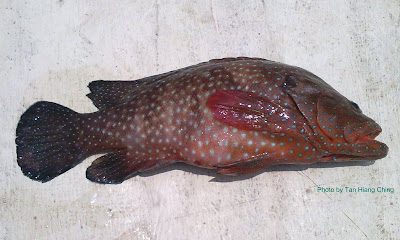
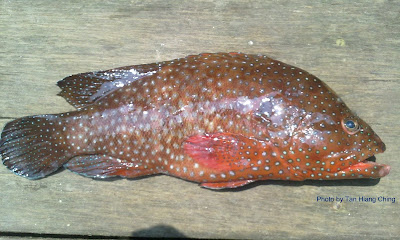
English Name: Bluelined Grouper, Bluelined Hind, Bluelined Rockcod
Chinese Name | 鱼类中文名: 石斑魚 (Shí bān yú), 蓝线石斑 (Lán xiàn shí bān)
Malay Name | Nama Melayu Malaysia: Ikan Kerapu Garis Biru
Thai Name | ชื่อสามัญภาษาไทย: ปลากะรังลายน้ําเงิน (Plā karạng lāy n̂̊ā ngein), ปลากะรังหิน (Plā karạng h̄in)
Local Hokkien: Thee Swa Gau
Local Teochew: Gao Hu
Local Cantonese: Seck Pan
Main Identification Features: Colour generally brown or yellowish brown, with dark blue lines on head, body, and fins. Black spot between upper 2 opercular spines.
Size: Maximum total length 34 cm.
Habitat and Ecology: Shallow dead and silty reefs, to 30 m depth. Feeds primarily on small fishes and crustaceans.
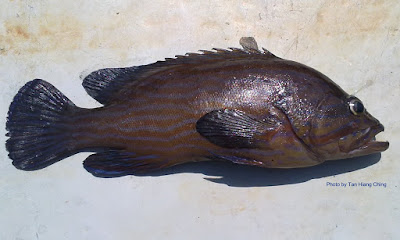
English Name: Humpback Grouper, Humpback Hind
Chinese Name | 鱼类中文名: 老鼠斑 (Lǎoshǔ bān), 驼背鲈 (Tuóbèi lú)
Malay Name | Nama Melayu Malaysia: Kerapu Tikus, Kerapu Belida, Sunoh
Thai Name | ชื่อสามัญภาษาไทย: ปลากะรังหน้างอน (Plā karạng h̄n̂ā ngxn)
Main Identification Features: Head small, strongly curved. Dorsal fin with 10 spines and 17 to 19 soft rays. Colour greenish white to light greenish brown with scattered round black spots on head, body, and fins.
Size: Maximum total length 70 cm.
Habitat and Ecology: Lagoons and sheltered coral reefs, to 40 m depth. Feeds primarily on small fishes and crustaceans. The species is a protogynous hermaphrodite.
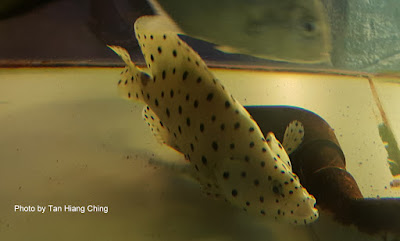
English Name: Barred Soapfish
French Name: Savon à deux bandes
Chinese Name | 鱼类中文名: 肥皂鱼 (Féizào yú)
Malay Name | Nama Melayu Malaysia: Kerapu Sebekah, Sebekah Laut
Thai Name | ชื่อสามัญภาษาไทย: ปลากะพงเหลืองเล็ก (Plā kaphng h̄elụ̄xng lĕk)
Main Identification Features: Body compressed with yellow colour posterior.
Size: Maximum total length 25 cm.
Habitat and Ecology: Coral reefs, to 50 m depth. Feeds mainly on fishes. Secretes the skin toxin grammistin under stress that resemble lathered soap.

English Name: Areolate Grouper
Chinese Name | 鱼类中文名: 石斑魚 (Shí bān yú), 西星斑 (Xi xīng bān)
Malay Name | Nama Melayu Malaysia: Kerapu Ekor Putih, Kerapu Bintik Bulat
Thai Name | ชื่อสามัญภาษาไทย: ปลากะรังลายหางตัด (Plā karạng lāy h̄āng tạd)
Local Hokkien: Koay Gau
Local Teochew: Gao Hu
Local Cantonese: Seck Pan
Main Identification Features: Head, body, and fins covered with numerous close-set brown, brownish yellow or greenish yellow spots. Posterior edge of caudal fin with a distinct white margin.
Size: Maximum total length about 40 cm.
Habitat and Ecology: Soft bottoms near reefs, to 200 m depth. Feeds on fishes and benthic invertebrates, primarily prawns and crabs.
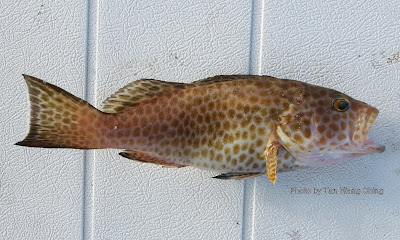
English Name: Yellow Grouper
Chinese Name | 鱼类中文名: 石斑魚 (Shí bān yú), 青石斑 (Qīng shí bān), 黄斑 (Huáng bān)
Malay Name | Nama Melayu Malaysia: Ikan Kerapu, Kerapu Sirip Kuning
Thai Name | ชื่อสามัญภาษาไทย: ปลาเก๋าบั้งแฉก (Plā kěā bậng c̄hæk)
Local Hokkien: Koay Gau
Local Teochew: Gao Hu
Local Cantonese: Seck Pan
Main Identification Features: Head length 2.3 to 2.6 times in standard length. Four dark bars, sometimes faint or absent. Dorsal, head and body with yellow spots. Soft dorsal, caudal, and sometimes the anal fin with prominent yellow margin.
Size: Maximum total length at least 60 cm, commonly 30 cm.
Habitat and Ecology: coral and rocky reefs and sandy-mud bottoms, to 50 m depth. Feeds on shrimp, crabs, fishes and cephalopods. The species is a protogynous hermaphrodite.
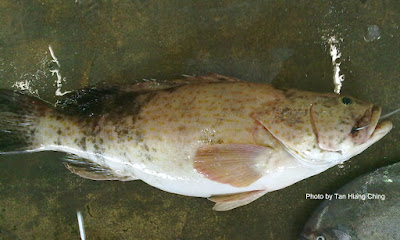
English Name: Duskytail Grouper
French Name: Mérou demideui
Chinese Name | 鱼类中文名: 石斑魚 (Shí bān yú), 红点油班 (Hóng diǎn yóu bān)
Malay Name | Nama Melayu Malaysia: Ikan Kerapu Ekor Gelap
Thai Name | ชื่อสามัญภาษาไทย: ปลากะรังจุดเหลือง (Plā karạng cud h̄elụ̄xng)
Local Hokkien: Koay Gau
Local Teochew: Gao Hu
Local Cantonese: Seck Pan
Main Identification Features: Dorsal fin and upper third of caudal fin with spots like those on body. Lower two-thirds of caudal fin dusky.
Size: Maximum total length about 76 cm.
Habitat and Ecology: Estuaries to rocky reefs, to 105 m depth. Feeds on small fishes, cephalopods and crustaceans.
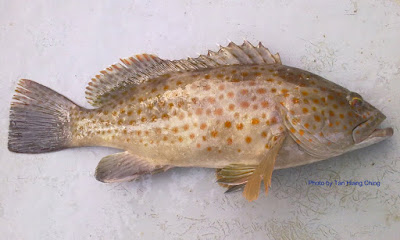
English Name: Orange-spotted Grouper, Goldspotted Rockcod, Brownspotted Grouper, Estuary Cod
French Name: Mérou taches oranges
Chinese Name | 鱼类中文名: 石斑魚 (Shí bān yú), 点带石斑 (Diǎn dài shí bān), 红点石斑 (Hóng diǎn shí bān)
Malay Name | Nama Melayu Malaysia: Ikan Kerapu bintik jingga, Kerapu Pinang, Kerapu Balong, Kerapu Rintek, Kerapu Pakpanang
Thai Name | ชื่อสามัญภาษาไทย: ปลากะรังดอกแดง (Plā karạng dxk dæng)
Local Hokkien: Chia Gau
Main Identification Features: Numerous small brownish orange or reddish brown spots on head, body, and median fins. Body with 5 faint, irregular, oblique, dark bars. Caudal fin not dusky.
Size: Maximum length at least 95 cm.
Habitat and Ecology: Estuaries to offshore, 1 to 100 m depth. Feeds on small fishes, shrimps, and crabs. The species is a protogynous hermaphrodite.
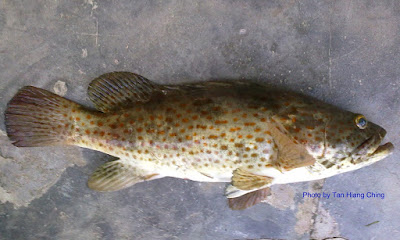
English Name: Coral Grouper
French Name: Mérou corail
Chinese Name | 鱼类中文名: 石斑魚 (Shí bān yú)
Malay Name | Nama Melayu Malaysia: Ikan Kerapu Karang, Kerapu Pisang
Thai Name | ชื่อสามัญภาษาไทย: ปลาเก๋าปะการัง (Plā kěā pakārạng)
Main Identification Features: Grey in colour, with well-separated black spots smaller than pupil on head, body and fins. 3 dusky to blackish blotches on body at base of rear half of dorsal fin. Dusky to blackish saddle spot on caudal peduncle.
Size: Maximum total length about 49 cm.
Habitat and Ecology: Estuaries and silty reefs, to 30 m depth.

English Name: Cloudy Grouper, Cloudy Rockcod, Garoupa
Chinese Name | 鱼类中文名: 石斑魚 (Shí bān yú), 石头斑 (Shítou bān)
Malay Name | Nama Melayu Malaysia: Ikan Kerapu Tompok Awan, Kerapu Combat
Malay Name | Nama Melayu Malaysia: Ikan Kerapu Karang, Kerapu Pisang
Thai Name | ชื่อสามัญภาษาไทย: ปลาเก๋าลายเมฆ (Plā kěā lāy meḳh), ปลากะรังลายตุ๊กแก (Plā karạng lāy túkkæ)
Local Hokkien: Koay Gau
Local Teochew: Gao Hu
Local Cantonese: Seck Pan
Main Identification Features: Body with white and brown patches that form many cloud like pattern.
Size: Maximum total length about 45 cm.
Habitat and Ecology: Estuaries and coastal muddy or silty-sand bottoms, 1 to 20 m depth. Feeds on small fishes, cephalopods and crustaceans.

English Name: Rock Grouper, Red Banded Grouper
Chinese Name | 鱼类中文名: 石斑魚 (Shí bān yú), 青眼斑 (Qīng yǎn bān)
Malay Name | Nama Melayu Malaysia: Ikan Kerapu Batu, Tongkah
Local Hokkien: Koay Gau, Gau Hu
Local Teochew: Gao Hu
Local Cantonese: Seck Pan
Main Identification Features: 5 slightly oblique broad dark bars usually visible on body. The last bar covering peduncle and the first 4 extending into dorsal fin. The first 2 bars are darker dorsally and extend to the margin of spinous dorsal fin.
Size: Maximum total length about 30 cm.
Habitat and Ecology: Shallow rocky areas, 15 to 30 m depth. Feeds on small fishes, prawns, crabs, worms, and gastropods. The species is a protogynous hermaphrodite.

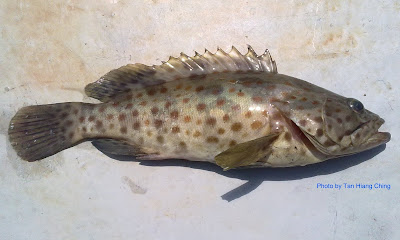
English Name: Blacktip Grouper
Chinese Name | 鱼类中文名: 石斑魚 (Shí bān yú), 黑边石斑 (Hēi biān shí bān), 赤石斑鱼 (Chì shí bān yú)
Malay Name | Nama Melayu Malaysia: Ikan Kerapu Sirip Hitam, Kerapu Merah
Thai Name | ชื่อสามัญภาษาไทย: ปลาเก๋าแดง (Plā kěā dæng)
Main Identification Features: The outer triangular part of interspinous membranes of dorsal fin black or dark red, with pale yellow or white spot behind tip of each spine.
Size: Maximum total length about 40 cm.
Habitat and Ecology: Coral reefs and rocky bottom, 4 to 160 m depth. Feeds primarily on fishes and crustaceans. The species is a protogynous hermaphrodite.
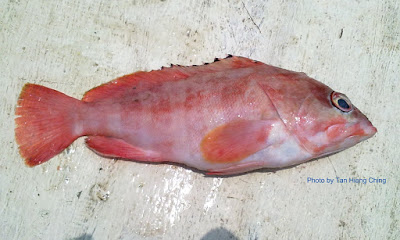
English Name: Giant Grouper, Brindlebass, Brown Spotted Cod, Bumblebee Grouper, Queensland Groper
Chinese Name | 鱼类中文名: 石斑魚 (Shí bān yú), 鞍帶石斑魚(Ān dài shí bān yú), 龙旦 (Lóng dàn)
Malay Name | Nama Melayu Malaysia: Ikan Kertang, Kerapu Pertang
Thai Name | ชื่อสามัญภาษาไทย: ปลาหมอทะเล (Plā h̄mx thale), ปลาเก๋ามังกร (Plā kěā mạngkr)
Local Cantonese: Long Tan
Main Identification Features: Fins (most visible on pectoral fin) with numerous small black spots. Body colour vary from juvenile to adult.
Size: One of the largest groupers, attains 270 cm total length. Maximum weight 400 kg.
Habitat and Ecology: Shallow inshore waters and estuaries, to 100 m depth, more often found in shallow waters. Feeds on spiny lobsters, fishes, crabs and prawns. The species is a protogynous hermaphrodite.
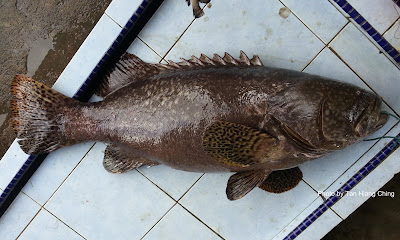

English Name: Longfin Grouper
Chinese Name | 鱼类中文名: 石斑魚 (Shí bān yú), 玳瑁石斑 (Dài mào shí bān), 蜜蜂斑 (Mì fēng bān)
Malay Name | Nama Melayu Malaysia: Ikan Kerapu Cicak, Kerapu Tukul
Thai Name | ชื่อสามัญภาษาไทย: ปลากะรังเสือครีบยาว (Plā karạng s̄eụ̄x khrīb yāw)
Local Teochew: Gao Hu
Local Cantonese: Seck Pan
Main Identification Features: Large, close-set, hexagonal to roundish, dark brown to blackish spots. Ventral edge of anal and caudal fins and leading edge of pelvic fins with white line and blackish submarginal band. Chest with 2 oblique dark brown bands or elongate dark blotches linked by narrow bands.
Size: Maximum total length 40 cm.
Habitat and Ecology: Inshore silty reefs, to 50 m depth. Feeds on shrimps, worms, small fishes and crabs. The species is a protogynous hermaphrodite.
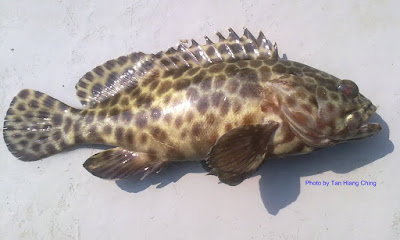
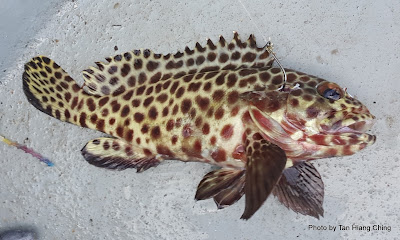
English Name: Sixbar Grouper, Garoupa
Chinese Name | 鱼类中文名: 石斑魚 (Shí bān yú), 糯米石斑 (Nuòmǐ shí bān)
Malay Name | Nama Melayu Malaysia: Ikan Kerapu Bebeh
Thai Name | ชื่อสามัญภาษาไทย: ปลากะรังลายน้ำตาล (Plā karạng lāyn̂ả tāl), ปลาเก๋าหกบั้ง (Plā kěā h̄k bậng)
Local Hokkien: Koay Gau
Local Teochew: Gao Hu
Local Cantonese: Seck Pan
Main Identification Features: Body pale to dark brown with 5 dark brown bars on body and 1 on nape. Relatively large dark spots on dorsal, anal and caudal fins.
Size: Maximum total length 28 cm.
Habitat and Ecology: Silty and muddy bottoms, 10 to 80 m depth. Feeds primarily on small fishes and crustaceans. The species is a protogynous hermaphrodite.
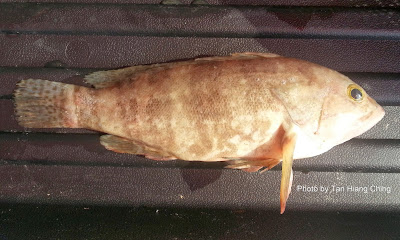
English Name: Greasy Grouper, Garoupa
Chinese Name | 鱼类中文名: 石斑魚 (Shí bān yú), Global - 鱸滑石斑魚(Lú huá shíbānyú)
Malay Name | Nama Melayu Malaysia: Ikan Kerapu Hitam, Kerapu Bunga
Thai Name | ชื่อสามัญภาษาไทย: ปลากะรังปากแม่น้ำ (Plā karạng pāk mæ̀n̂ả)
Local Hokkien: Koay Gau
Local Teochew: Gao Hu
Local Cantonese: Seck Pan
Main Identification Features: Covered with dull orange-red to dark brown spots. Spots on head progressively smaller anteriorly. Large black blotch (or group of black spots) often visible at base of last 4 dorsal-fin spines and extending onto lower part of fin.
Size: Maximum total length 75 cm.
Habitat and Ecology: Clear waters of coastal, lagoon and coral reefs, 10 to 80 m depth. Feeds primarily on small fishes and sometimes on crustaceans. The species is a protogynous hermaphrodite.
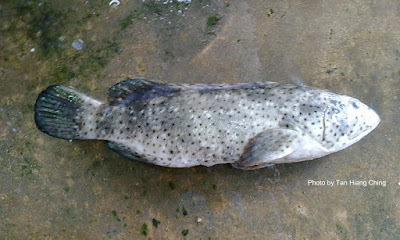
English Name: Squaretail Coralgrouper, Passionfruit Coral Trout
Chinese Name | 鱼类中文名: 石斑魚 (Shí bān yú), 西星斑 (Xī xīng bān)
Malay Name | Nama Melayu Malaysia: Kerapu Ekor Putih, Kerapu Sunoh Ekor Pepat
Thai Name | ชื่อสามัญภาษาไทย: ปลากุดสลาดจุดฟ้า (Plā kud s̄lād cud f̂ā), ปลากุดสลาดหางตัด (Plā kud s̄lād h̄āng tạd)
Local Hokkien: Ang Gau
Main Identification Features: Body with many small round to oval dark-edged blue spots. Large canine teeth at front of jaws. Truncate caudal fin. Rear margin of caudal fin with a white edge and often with a blackish submarginal band.
Size: Maximum total length about 100 cm.
Habitat and Ecology: Coral reefs, to 70 m depth. Feeds on fishes.


English Name: Common Coral Trout, Leopard Trout, Leopard Coralgrouper
Chinese Name | 鱼类中文名: 石斑魚 (Shí bān yú), 七星斑 (Qī xīng bān)
Malay Name | Nama Melayu Malaysia: Kerapu Sunoh Bara, Kerapu Bintang
Thai Name | ชื่อสามัญภาษาไทย: ปลากุดสลาดแดงจุดฟ้า (Plā kud s̄lād dæng cud f̂ā), ปลากะรังจุดฟ้าจุดเล็ก (Plā karạng cud f̂ā cud lĕk)
Local Hokkien: Ang Gau
Main Identification Features: Body covered in a profusion of small blue dots. Pectoral fin transparent and without blue dots. Distinctive blue ring around the eye.
Size: Maximum standard length 120 cm, commonly 35 cm.
Habitat and Ecology: Coral reefs, to 100 m depth. Feeds mainly on fish and invertebrates such as crustaceans and squid. The species is a diandric protogynous hermaphrodite.

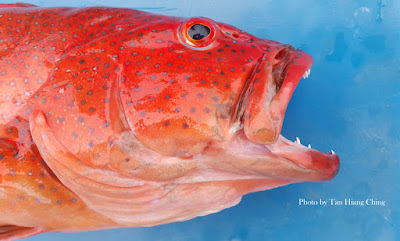
English Name: Barcheek Coral Trout, Spotted Coralgrouper
Chinese Name | 鱼类中文名: 石斑魚 (Shí bān yú), 东星斑 (Dōng xīng bān)
Malay Name | Nama Melayu Malaysia: Ikan Kerapu Sunoh Pisang, Kerapu Bara
Thai Name | ชื่อสามัญภาษาไทย: ปลากะรังจุดฟ้าจุดใหญ่ (Plā karạng cud f̂ā cud yai)
Local Hokkien: Chut Bee Gau, Ang Gau
Main Identification Features: Head, body, and median fins greenish grey, brown, red, or orange-red, with dark-edged blue spots. Spots on head and anterior part of body oval or horizontally elongated. The spots become much smaller, more uniformly round, and more numerous on rear part of body and on fins.
Size: Maximum total length about 125 cm.
Habitat and Ecology: Coral reefs, to 100 m depth. Feeds on small fishes and invertebrates such as crustaceans and squids. The species is a protogynous hermaphrodite.

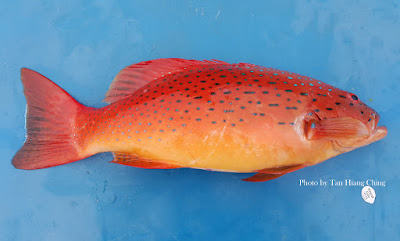

English Name: White-edged Lyretail, White-edged Lunartail
Chinese Name | 鱼类中文名: 石斑魚 (Shí bān yú), 白缘星鲙 (Bái yuán xīng kuài)
Malay Name | Nama Melayu Malaysia: Kerapu Sabit Putih
Thai Name | ชื่อสามัญภาษาไทย: ปลากะรังหางวงเดือนขอบขาว (Plā karạng h̄āng wngdeụ̄xn k̄hxb k̄hāw)
Main Identification Features: Caudal fin lunate. Margin of caudal fin with a narrow white edge.
Size: Maximum total length 47 cm.
Habitat and Ecology: Coral reefs, 4 to 200 m depth. Occurs solitary and in small groups. Feeds primarily on small fishes.
